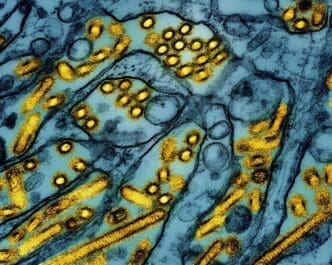A resident of Louisiana has been hospitalized with bird flu, marking the first severe human H5N1 infection reported in the United States, according to the Centers for Disease Control and Prevention (CDC).
“The patient is suffering from severe respiratory illness linked to H5N1 and is currently in critical condition,” said Emma Herrock, a spokesperson for the Louisiana Health Department.
The CDC indicated that the individual likely contracted the virus through a backyard flock, a first for such a flock being associated with a bird flu infection in a U.S. resident.
“An investigation into the source of this infection is ongoing, but it is believed the patient had contact with sick or dead birds on their property,” stated Dr. Demetre Daskalakis, director of the National Center for Immunization and Respiratory Diseases, during a briefing on Wednesday.
The case was initially reported as presumptive positive by Louisiana on Friday and subsequently confirmed through CDC laboratory testing.
Daskalakis mentioned that the Health Department is conducting an investigation, monitoring the patient’s contacts for potential exposure, and providing testing and antiviral treatment as necessary.
The patient, who is over 65 years old and has underlying medical conditions, has not had any further information released regarding their symptoms or the backyard flock, according to Herrock.
This year, a total of 61 human cases of avian influenza have been reported in the United States. Wisconsin officials announced on Wednesday that they had identified a probable case involving an individual exposed to infected birds at a commercial poultry operation, pending confirmation by the CDC.
There has been no documented transmission of bird flu between humans to date. Most cases have been mild and typically involve individuals working on farms in contact with infected poultry or cattle. Common symptoms in previous cases have included pinkeye, coughing, and sneezing.
Dr. Peter Chin-Hong, a professor of medicine at the University of California San Francisco specializing in infectious diseases, stated that the Louisiana case underscores the risks of exposure beyond traditional farming environments. “While we’ve been focusing on dairy and poultry workers, there’s an emerging risk tied to handling dead birds in your backyard,” he noted.
Daskalakis explained that the CDC is working to better understand the virus’s genetic makeup, which will assist researchers in determining whether it has developed any concerning mutations that could enable it to spread between people.
Initial assessments suggest that the strain responsible for the Louisiana infection is similar to one circulating among wild birds and poultry in British Columbia, Canada, and Washington state.
In November, a teenager in British Columbia was hospitalized after contracting the same strain of bird flu; however, Canadian health officials were unable to identify how the teen was infected.
“What this illustrates is that people can become seriously ill from bird flu, which relates to the case in British Columbia,” Chin-Hong remarked. “Both patients share the same variant.”
Despite these developments, the CDC maintains that the immediate public health risk posed by H5N1 remains “low.”
H5N1 began to circulate widely among wild birds in the U.S. in 2022 and subsequently spread to poultry farms and backyard flocks. Since then, over 123 million birds have been euthanized or killed due to the virus, according to the CDC.
This spring, H5N1 began spreading among dairy cows, with the virus now detected in at least 16 states.
Research has indicated that the virus can spread effectively among mammals, likely transmitted between farm animals through raw milk, as infected cows can excrete large quantities of the virus via their mammary glands.
Although there is currently no evidence of human-to-human transmission, there are concerns that the virus could mutate and acquire that capability, potentially leading to a future pandemic.
In the U.S., there have been two cases where health officials could not determine the source of a person’s exposure to bird flu—one involving a child in California reported in November and another involving a hospitalized patient in Missouri who tested positive for H5N1 in August and later recovered.
Daskalakis noted that the CDC considers the Louisiana case as the first severe H5N1 infection, as it is believed that other conditions contributed to the hospitalization of the patient in Missouri.
Additionally, Delaware health officials reported a possible case of H5N1 this week in an individual with no known exposure to poultry or cattle. However, CDC testing could not confirm that the virus was indeed H5N1, so this case has been classified as “probable.”
Source: nbcnews.com








